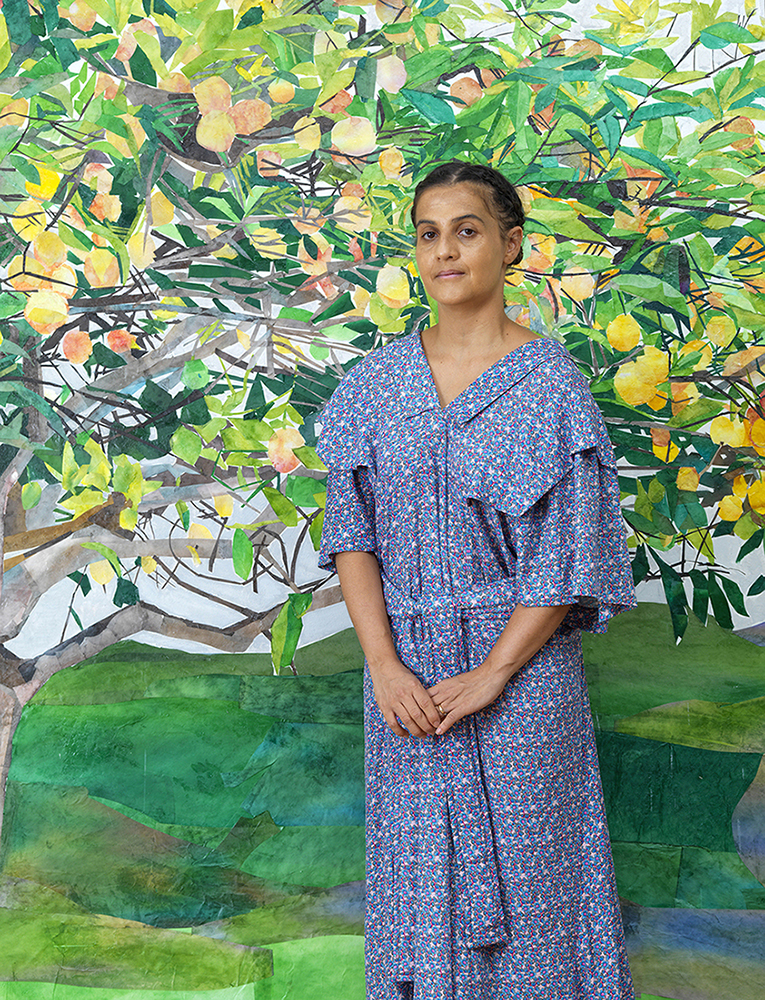María Berrío: Flowered Songs and Broken Currents
6 October–18 December 2020
‘This exhibition began with the idea of a fictional town attempting to overcome a catastrophe, but it soon opened outwards into my own response to a very real, global catastrophe.’ — María Berrío
The central theme of this exhibition is the quiet of catastrophe’s aftermath, a solemnity that points as much towards modes of resilience and adaptation as it does to the crushing devastation of loss. This theme takes shape through María Berrío’s narration of a small Colombian fishing village that has undergone a tragedy. In these works, the artist explores how the formation of historical memory occurs amidst processes of grieving in a village that maps the site of her own imagination.
Writing about the series, Berrío states, ‘At the end of 2019, I started researching the history of small fishing villages in Colombia. I quickly became intrigued by the stories of these villages and their inhabitants, dark tales of environmental and political catastrophe. In each instance, however, I also encountered stories of resilience, of individuals miraculously cultivating hope from barren soil. These stories inspired me to imagine my own fishing village, this one steeped in the language and mythos of magical realism. Though the armature I constructed was a fiction, it was nonetheless tinged with real events. My paintings became a medium through which to channel the feelings and emotions that reverberated outwards from these events.
As the coronavirus pandemic emerged and threw 2020 into tumult, the lines demarcating my imaginary village from the reality in which I live seemed to smudge and blur. Though external circumstances may have shifted, however, my drive to create art – to respond to the world, to push back against the prevailing fear and anxiety – endured. This series explores the silence that follows in the wake of a catastrophe, the modes of resilience and adaptation that arise and evolve out of the crushing devastation of loss. Neither wholly real nor wholly imagined, these large-scale paintings depict the scenes that follow after tragedy, the ruined homes and landscapes that situate the women and children who have been left behind. I believe grieving is a process of opening oneself to the world in all its diversity and imperfection. With Flowered Songs and Broken Currents I offer a vision of what comes after certainty.
This exhibition began with the idea of a fictional town attempting to overcome a catastrophe, but it soon opened outwards into my own response to a very real, global catastrophe. The lines that distinguish art from life and life from art inevitably dissolved in its making.’
Clouded Infinity, 2020
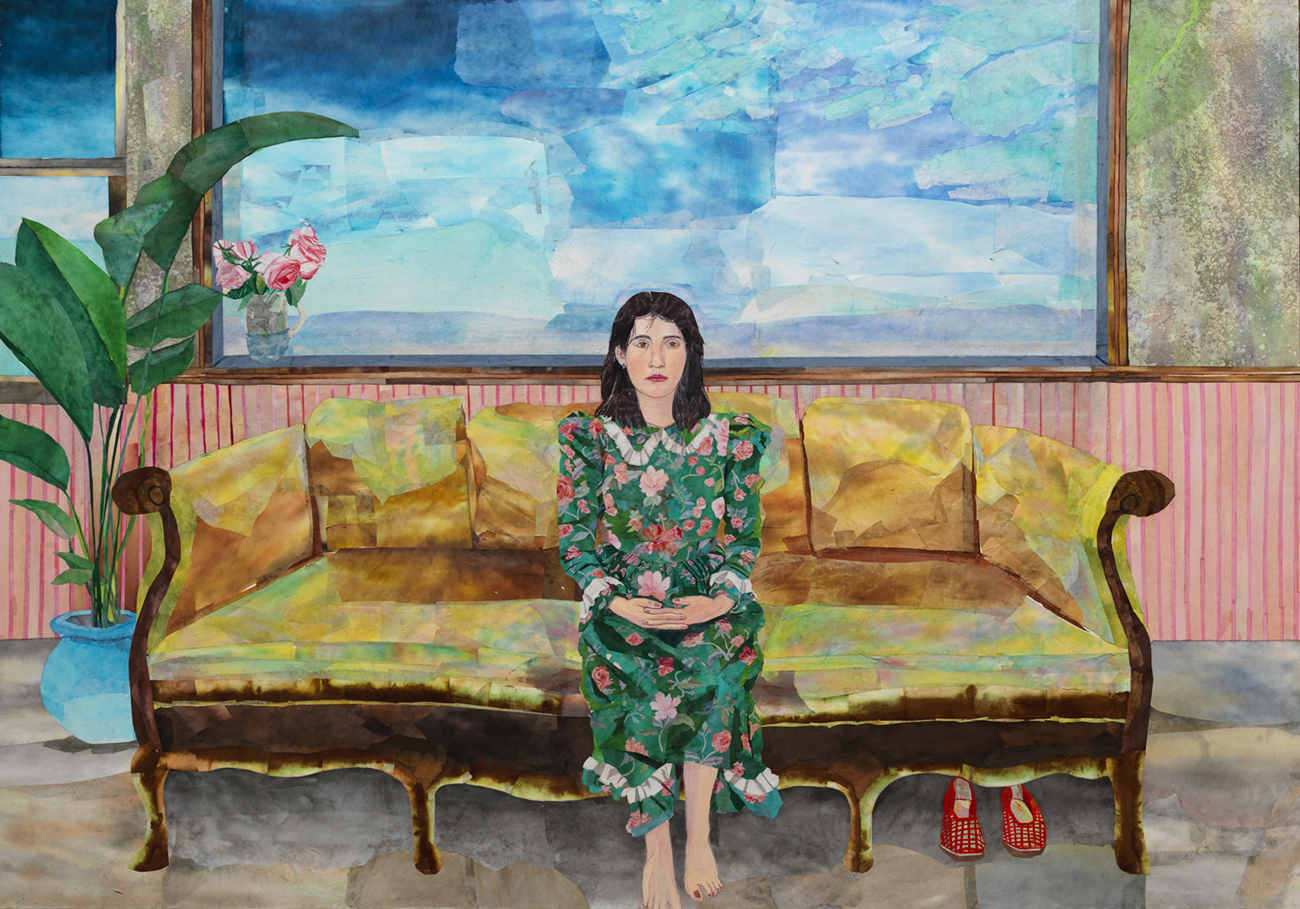
Collage with Japanese paper and watercolour paint on canvas
213.4 x 304.8 cm
84 x 120 in
María Berrío, Clouded Infinity, 2020
More info‘This piece is very much about the flowering of hope amidst sadness and grief.’— María Berrío
‘Clouded Infinity began with the idea of life cycles. It depicts a woman early in her pregnancy, perhaps around four months. Her hands clasp her belly, cradling its small bulge. The room she sits in is large and empty, save for a plant, some flowers, and her shoes. I wanted to capture the feeling I felt in the first uncertain months of my own pregnancy. Any attempt to imagine the future seemed impossible, like looking into a mirror fogged with breath. This piece is very much about the flowering of hope amidst sadness and grief. Despite all the loss around us, children are still being born. These new lives arriving during this time bring a glimpse of joy and unconditional love.’
There Is No Sky for Ground Spirits, 2020
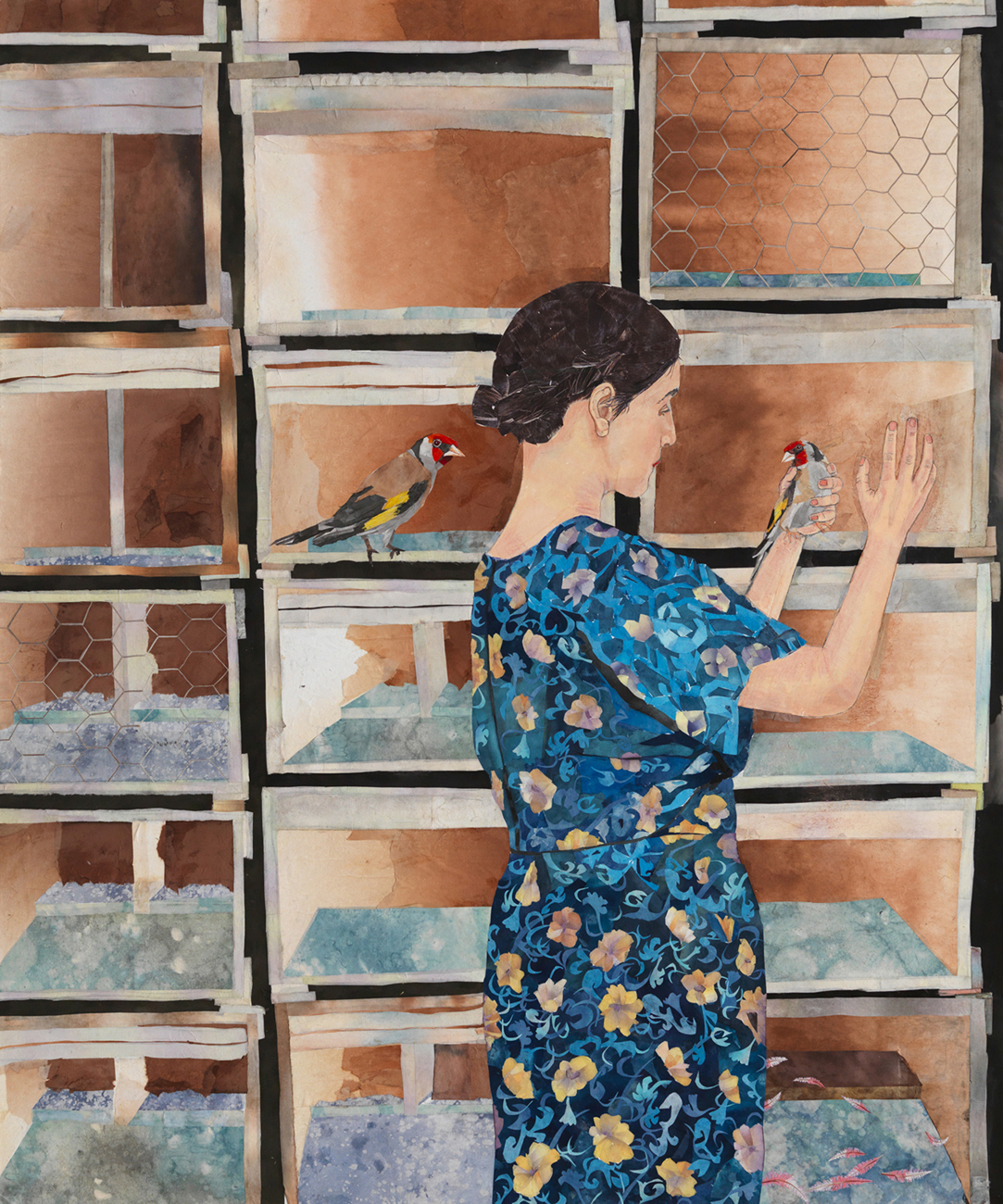
Collage with Japanese paper and watercolour paint on canvas
182.9 x 152.4 cm
72 x 60 in
María Berrío, There Is No Sky for Ground Spirits, 2020
More info‘This nods to our attempts to categorise and frame events, to contain them in a way that enables us to understand them.’— María Berrío
‘In this piece, a woman is standing in front of a cabinet, flanked by two birds representing her past and her present. She grabs the present in her hand, but her past remains beside her, impossible to leave behind. The woman’s spirit, growth, and origins are likewise represented by these birds. Yet the birds are in coops. This nods to our attempts to categorise and frame events, to contain them in a way that enables us to understand them. What does it mean, then, that many of the coops are vacant? Does this show the expanse of possibility before us? Or the dearth of past events that enable the woman to face the present? Perhaps it is the future, with no bird to represent it, that is best symbolised through the emptiness of these constructed boxes.’
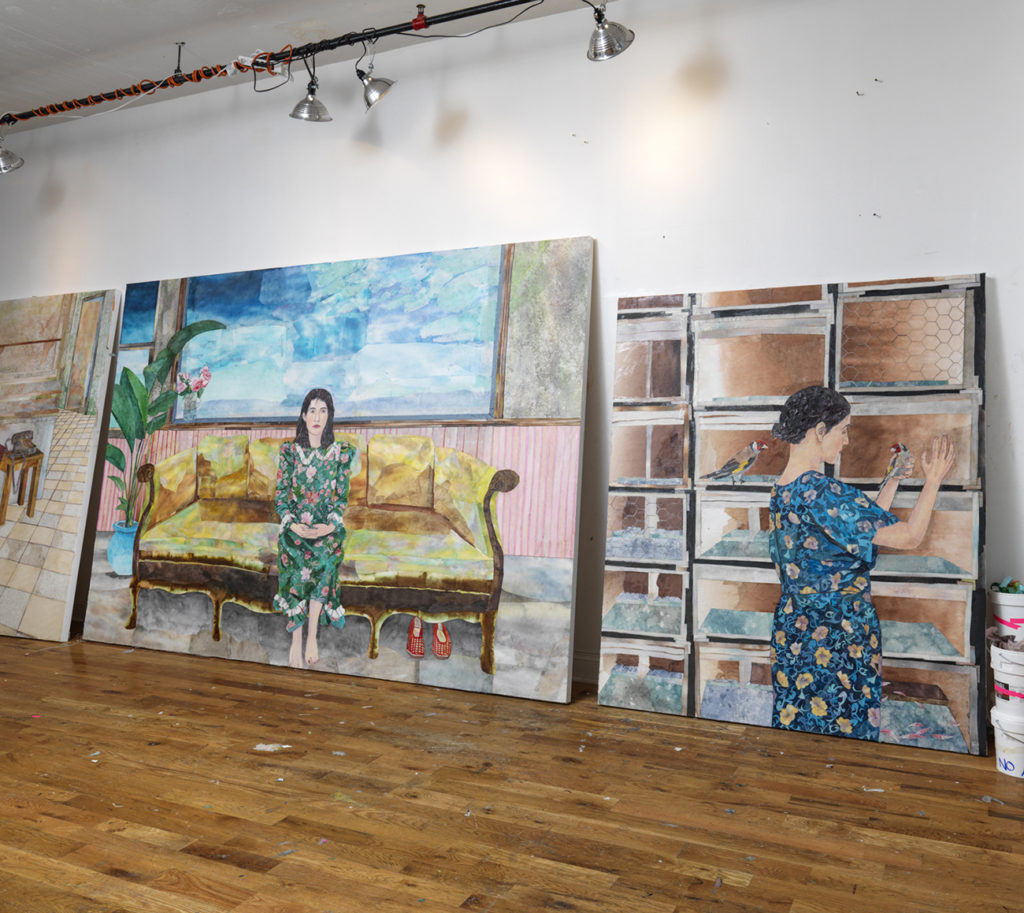
Crowned Solitudes, 2020
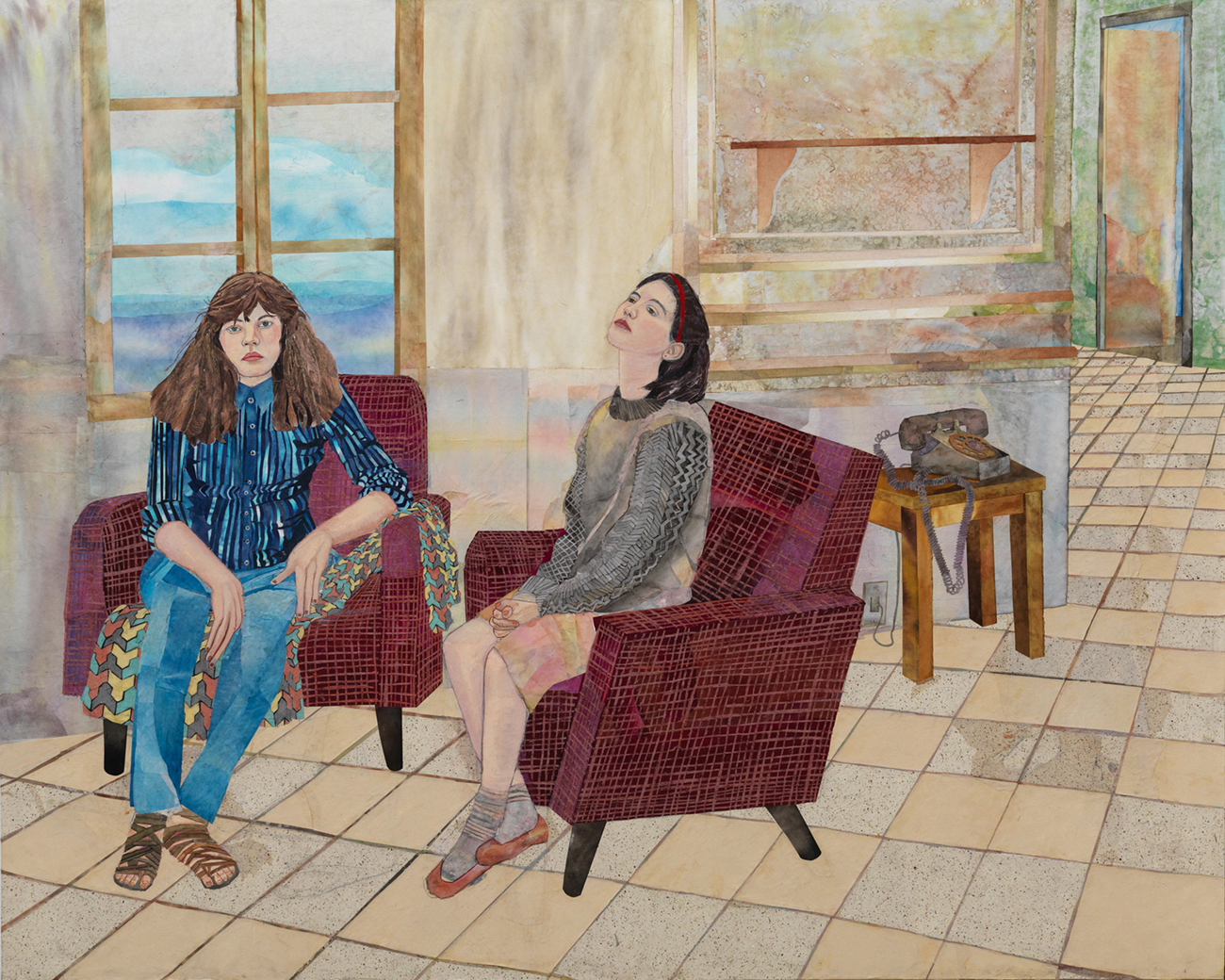
Collage with Japanese paper and watercolour paint on canvas
213.4 x 266.7 cm
84 x 105 in
María Berrío, Crowned Solitudes, 2020
More info‘There is something that bonds the two of them, a very special bond, a sisterhood.’— María Berrío
‘For me, this piece was all about the emotion of the two women who share its space. The pose of the woman on the left projects an image of strength. The woman on the right strikes an anguished pose, her hands and legs tightly clasped. They each manifest a different reaction to their common attempt to find their way through grief, through emotional and mental anguish. They both are waiting for something to happen, some kind of news , but they are waiting together. There is something that bonds the two of them, a very special bond, a sisterhood.’
Ananda Tandava, 2020
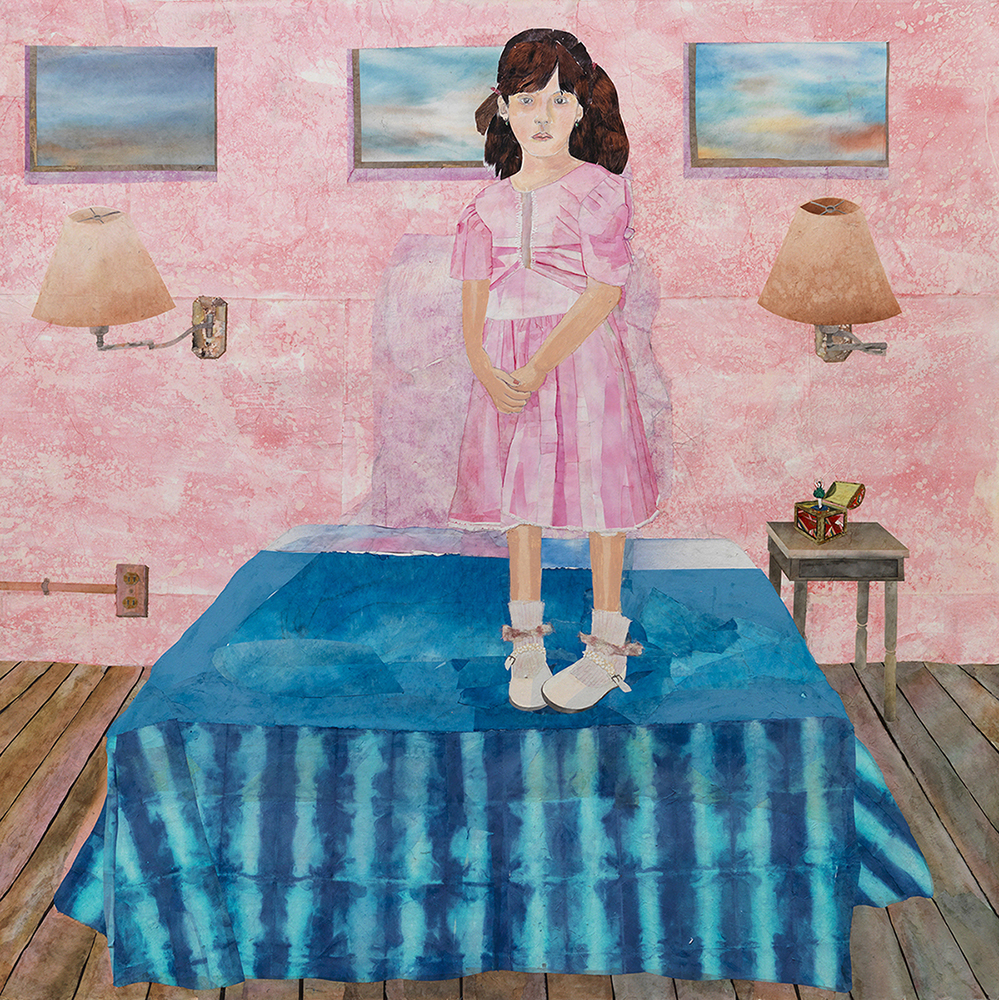
Collage with Japanese paper, watercolour paint, and coloured pencils on canvas
213.4 x 213.4 cm
84 x 84 in
María Berrío, Ananda Tandava, 2020
More info‘The room is not merely a refuge but a stage in which the girl acts out the drama of creation; it is a place of world-making.’ — María Berrío
‘In this painting, a girl stands perched on her bed. A music box sits on the nightstand to her left. Alone in her room, the girl is in the process of creating her own imaginary universe, as any child left to her own devices might do. Within the confines of her pink room, she dances out the rhythms of her own inner world. These dances follow the rhythms of the Hindu god Shiva, who dances the Ananda Tandava (the dance of bliss), a cosmic dance whereby the entirety of existence, from birth to end, is articulated by the choreographed movements of the divine dancer. The three paintings that hang on the wall behind the girl symbolise the new heavens that she is in the process of dancing into existence.’
Under a Cold Sun, 2020
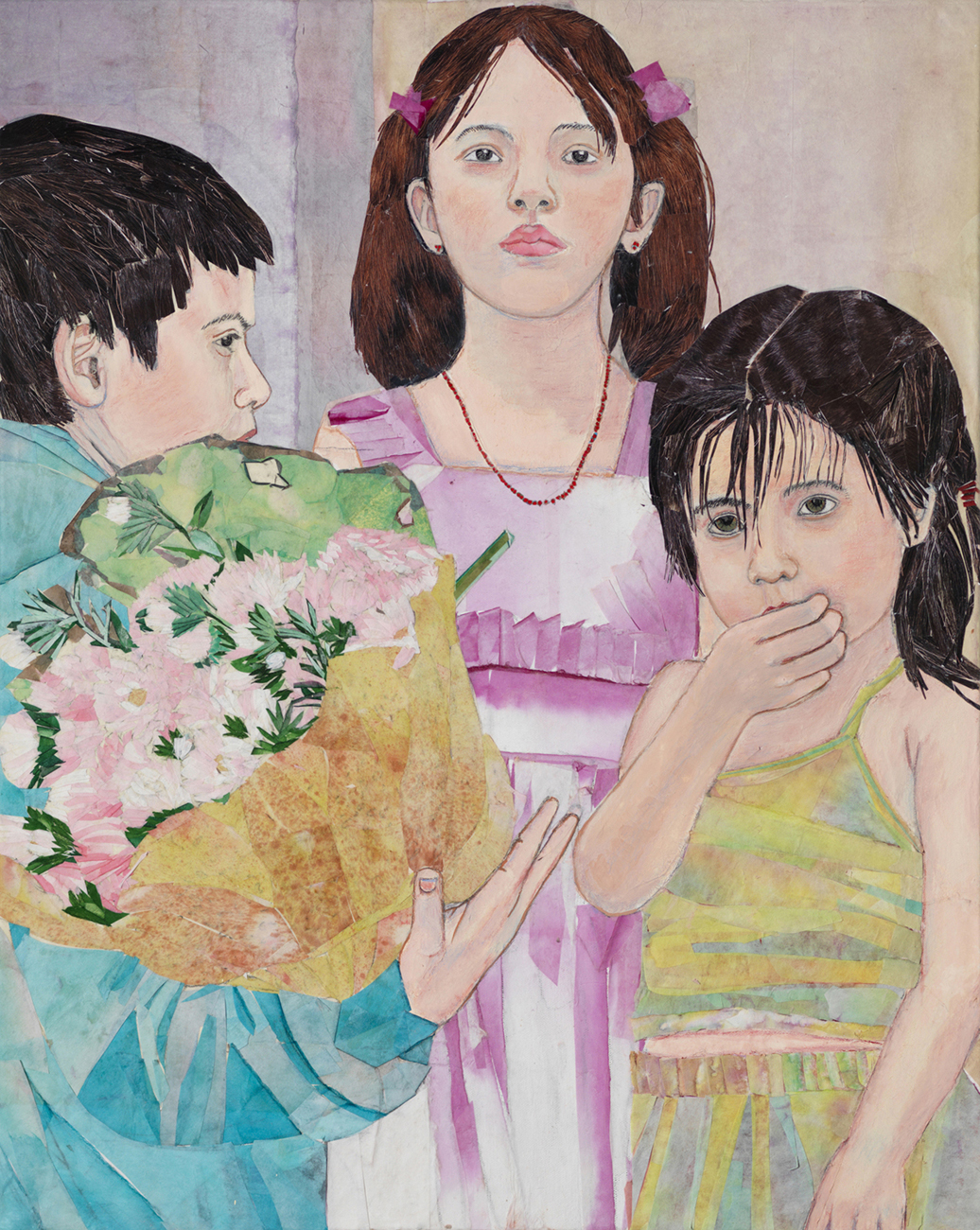
Collage with Japanese paper and watercolour paint on canvas
76.2 x 61 cm
30 x 24 in
María Berrío, Under a Cold Sun, 2020
More info‘These children are a personification of resilience and the will to live.’— María Berrío
‘The three children depicted here are children in age only. They heft the burden of the adult world on their young shoulders; circumstance has matured them far beyond their years. Perhaps it was the catastrophe that befell their village that pushed them to their fates. Despite growing far from the warmth of caring guardians, invisible to the sun’s rays, these children are a personification of resilience and the will to live.’
The Combed Thunderclap, 2020
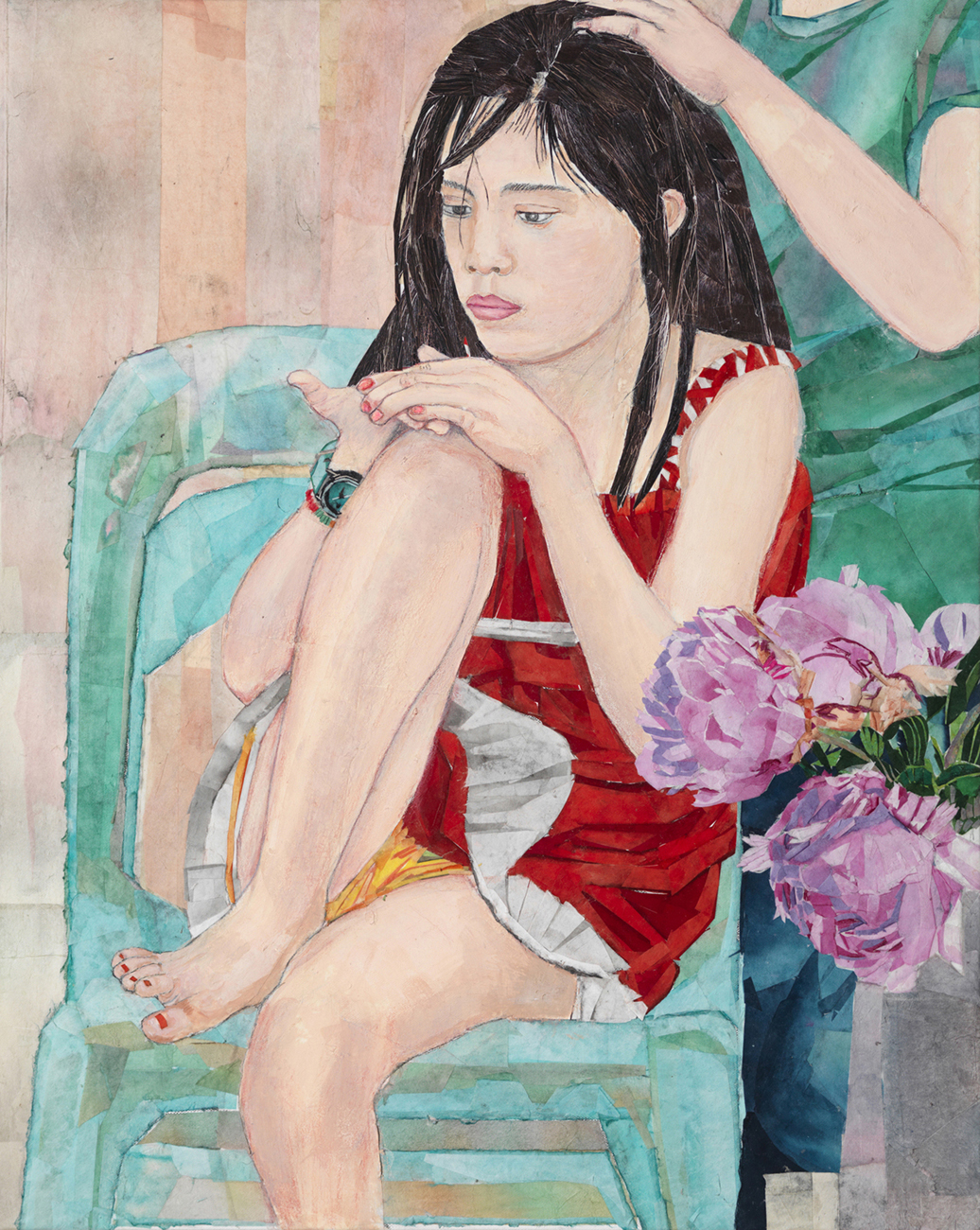
Collage with Japanese paper and watercolour paint on canvas
76.2 x 61 cm
30 x 24 in
María Berrío, The Combed Thunderclap, 2020
More info‘The girl is a tangle of knees and nerves, a creature not far from entering adolescence but already a roiling force.’— María Berrío
‘The Combed Thunderclap takes its title from Borges’ short story, The Library of Babel. It depicts a girl who seems utterly absorbed by the intricate mysteries of her palm. Behind her stands a cropped figure, grooming the girl’s hair. The girl is a tangle of knees and nerves, a creature not far from entering adolescence but already a roiling force. She is a complete entity unto herself, focused only on the charged ions of her own being. She is unpredictable and prone to outbursts, a force to be reckoned with. And yet in this image we find the girl in a temporary state of calm, a thunderclap in a brief moment of repose.’
Miracles of Ordinary Light, 2020
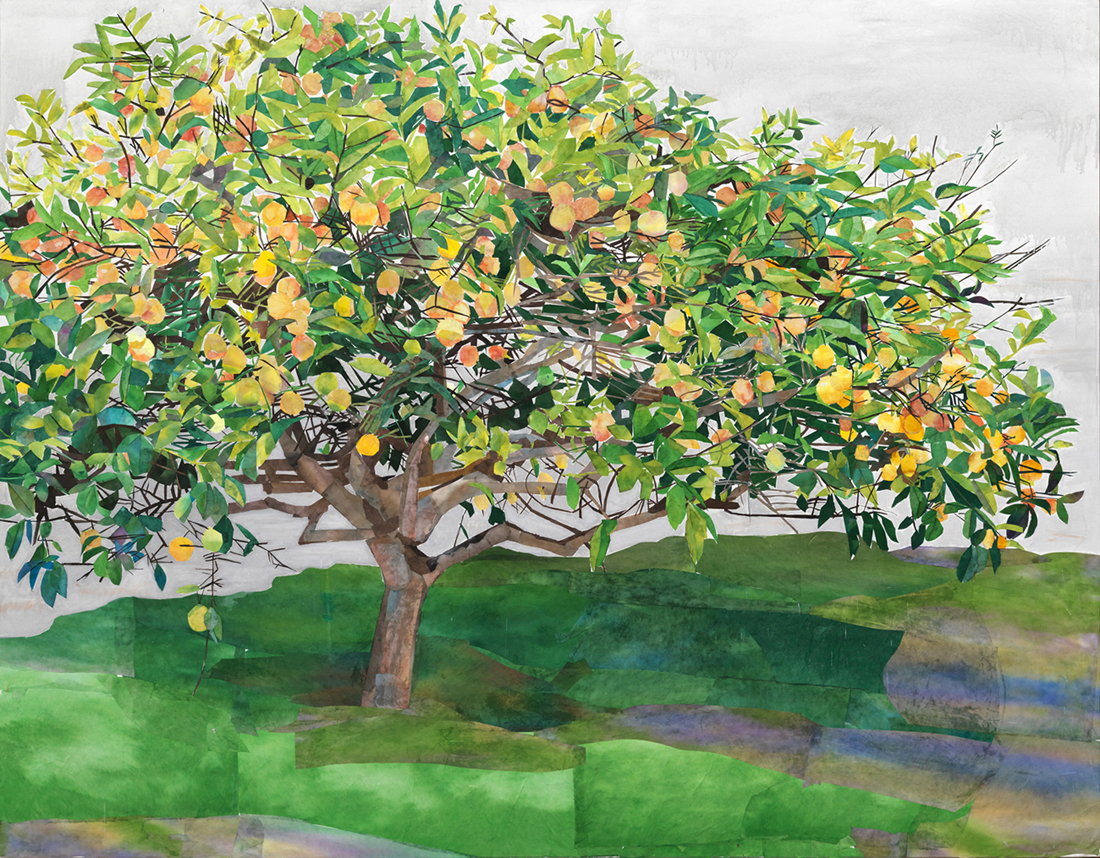
Collage with Japanese paper and watercolour paint on canvas
233.7 x 299.7 cm
92 x 118 in
María Berrío, Miracles of Ordinary Light, 2020
More info‘By distancing ourselves mentally, technologically, and materially from nature, we not only fail to see nature’s wonder but also our own place in that wonder.’— María Berrío
‘Unlike the other works, there is no figure in this painting. The beauty and glory of nature is figure enough. As humans, we tend to lock ourselves in our own worlds, beholden to our own joys and sorrows, ignoring our part in the larger circle of life as if we could remove ourselves from it. By distancing ourselves mentally, technologically, and materially from nature, we not only fail to see nature’s wonder but also our own place in that wonder. We react in shock and horror to discover that we, too, are but one fragment of something far grander than our laughter and sadness. This tree, like all trees – as well as all birds, mountains, stars, and people – will live, die, and be reborn again. Even when our species completes its designated passage through the universe, the world will continue to turn, the cycle persisting indomitably. Our place in this wondrous continuum is reason enough for hope.’
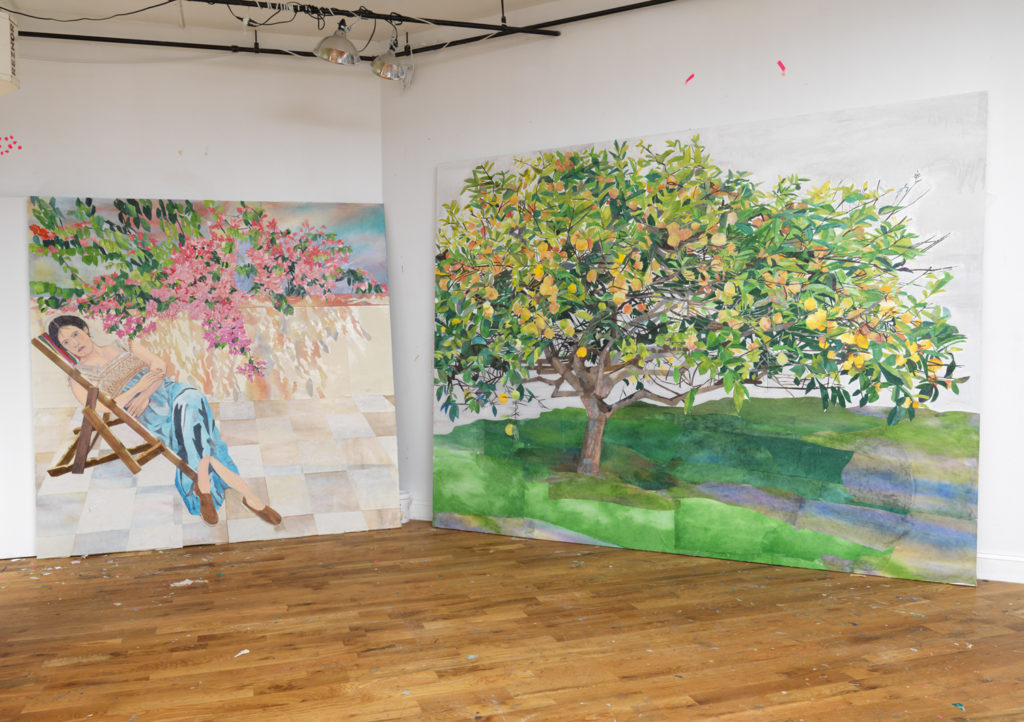
The Quiet Undoing, 2020
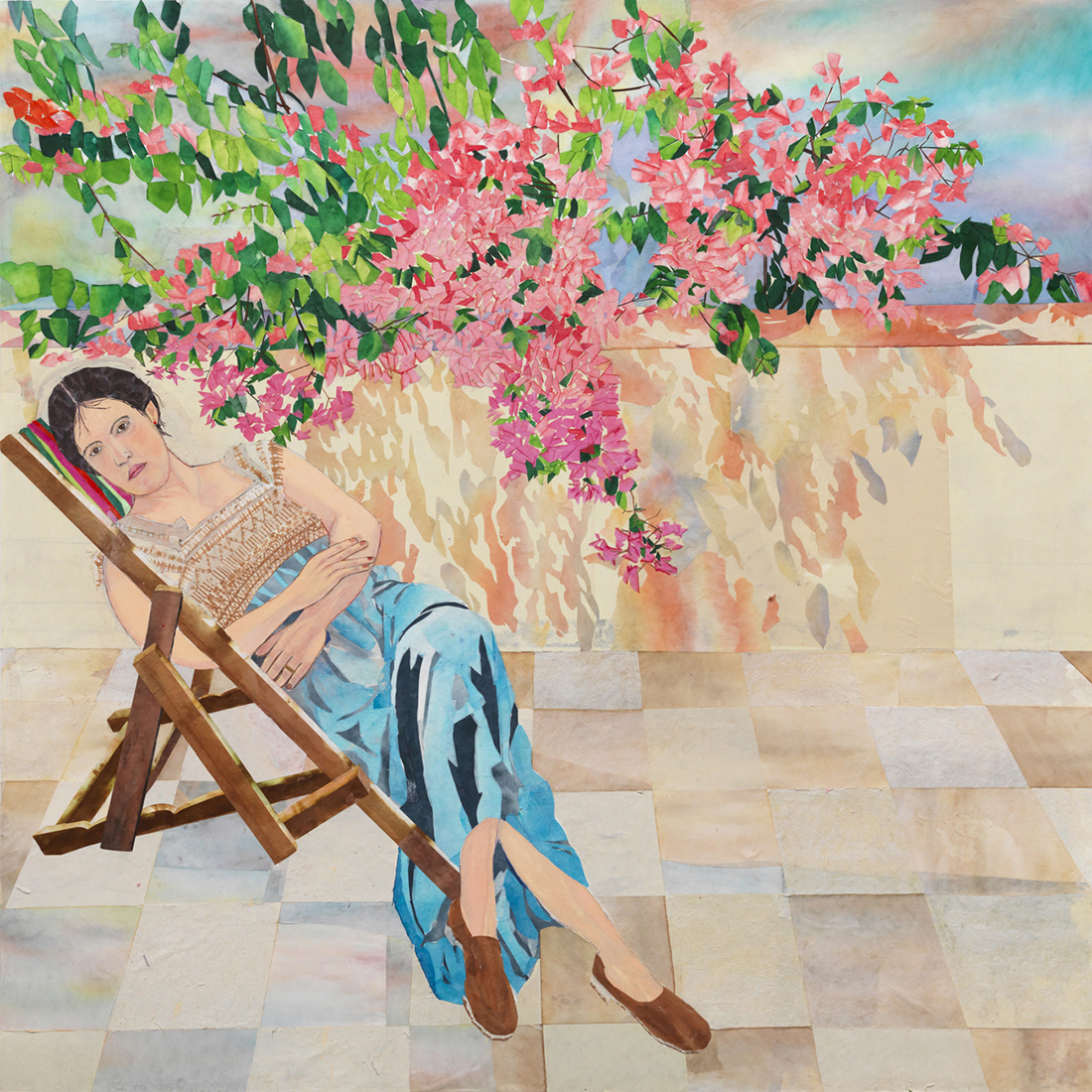
Collage with Japanese paper and watercolour paint on canvas
213.4 x 213.4 cm
84 x 84 in
María Berrío, The Quiet Undoing, 2020
More info‘This last piece was me trying to take a deep breath, trying to smell the sea, trying to cultivate the same hope, endurance, and adaptation that animate the figures of my work.’— María Berrío
‘Bougainvillea is one of my favourite flowers. It reminds me of growing up in Colombia, where you can see its splendour everywhere in absurd abundance. One of the reasons I wanted to paint this flower was because of its “paper-like” quality: when I see them, they remind me of the paper I use to create my paintings.
This was the last piece I created for this exhibition. On reflection, I think of this painting as a manifestation of my own hopes and desires: a warm afternoon, a calm atmosphere, a day of contemplation, a day of silence and reflection. The months that have accompanied the making of the works for this show have been full of noise and fear. I would walk anxiously to the studio through the once busy streets of Brooklyn, now deserted, painting while I listened to the governor of New York’s daily briefings on the pandemic. The soundscape of these works was itself a collage: the grim tally of rising casualties and declining hospital beds and supplies, the daily applause for healthcare workers, the ubiquitous wail of ambulances and the ricochets of illegal fireworks, the chants and demands of protesters and the hum of police helicopters.
These are paintings made while grieving, every day grieving. These are paintings made in a very specific historical moment, when the fragility of each individual’s plans and hopes and dreams were laid bare and made irrelevant in the face of the potential undoing of our civilization. This last piece was me trying to take a deep breath, trying to smell the sea, trying to cultivate the same hope, endurance, and adaptation that animate the figures of my work.’
About the artist
Based in Brooklyn, María Berrío was born and grew up in Colombia. Her works, which are meticulously crafted from layers of Japanese paper, reflect on cross-cultural connections and global migration seen through the prism of her own history.
María Berrío’s work is in permanent collections including the Whitney Museum of American Art, New York, USA; National Gallery of Art, Washington DC; Crystal Bridges Museum of American Art, USA; Nasher Museum of Art at Duke University, USA; Pérez Art Museum, Miami, USA and Pennsylvania Academy of the Fine Arts, Philadelphia, USA, among others. Her work has been shown as part of significant exhibitions at the Philadelphia Museum of Art, USA; Nasher Museum of Art, USA; Prospect.4 Triennial, New Orleans; and the Museo del Barrio, New York. The Norton Museum of Art in West Palm Beach, is organising the first survey of Berrío’s work, scheduled to open in early 2021.
